LoraKim Joyner's Blog
November 26, 2019
Bird with a Badge
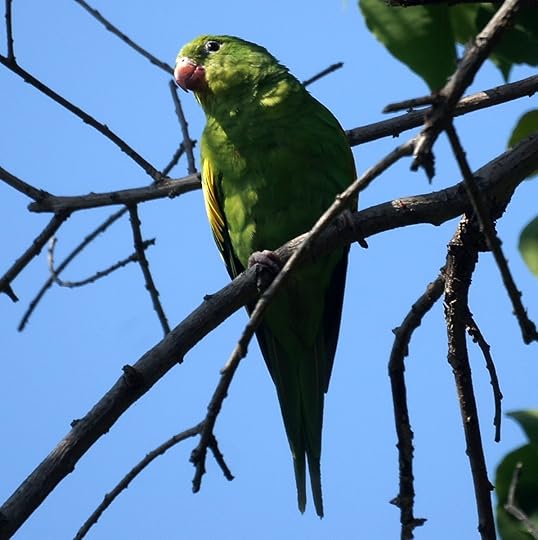 Photo credit: Mike's BirdsLoraKim is now in Guyana through the end of November. While she is gone, we will be focusing on her thoughts (and mine) on why parrots are so much more than beautiful (even as we admire their physical beauty!).The seventh bird on LoraKim Joyner’s list of the most beautiful parrots is the yellow-chevroned parakeet (its scientific name is Brotogeris chiriri). Wondering what a “chevron” is, I looked it up and one of the definitions is “a badge consisting of stripes meeting at an angle, worn on the sleeve by noncommissioned officers, police officers, etc., as an indication of rank, service, or the like.” (The other definition is “an ornament in this form, as on a molding.”) Looking at these lovely little birds, I can see how they got their name.Here are LoraKim’s thoughts about the yellow-chevroned parakeet, “Often when we are out doing parrot surveys in various countries some member of the Brotogeris genera fly by, so high, erratically, and fast. You can’t really see much of them. Their flamboyant calls and flight patterns, though, tell you who they are. Sometimes they deem to come down to earth closer to us, hold still, and then if you are lucky, the beautiful yellow-chevroned parakeet offers up a glimpse of the yellow on their wings. When they do this, it’s like you feel chosen and as special as they are. I had one of these in my home in my younger years, and the bird followed me everywhere, and though now long gone, her memories and her beauty have never left my heart.”The List:Yellow-naped amazonScarlet macawYellow-faced parrotNanday ParakeetHyacinth MacawPacfic ParakeetYellow-chevroned ParakeetSun ParakeetAustralian BudgerigarCarolina ParakeetHeracles inexpectatus
Photo credit: Mike's BirdsLoraKim is now in Guyana through the end of November. While she is gone, we will be focusing on her thoughts (and mine) on why parrots are so much more than beautiful (even as we admire their physical beauty!).The seventh bird on LoraKim Joyner’s list of the most beautiful parrots is the yellow-chevroned parakeet (its scientific name is Brotogeris chiriri). Wondering what a “chevron” is, I looked it up and one of the definitions is “a badge consisting of stripes meeting at an angle, worn on the sleeve by noncommissioned officers, police officers, etc., as an indication of rank, service, or the like.” (The other definition is “an ornament in this form, as on a molding.”) Looking at these lovely little birds, I can see how they got their name.Here are LoraKim’s thoughts about the yellow-chevroned parakeet, “Often when we are out doing parrot surveys in various countries some member of the Brotogeris genera fly by, so high, erratically, and fast. You can’t really see much of them. Their flamboyant calls and flight patterns, though, tell you who they are. Sometimes they deem to come down to earth closer to us, hold still, and then if you are lucky, the beautiful yellow-chevroned parakeet offers up a glimpse of the yellow on their wings. When they do this, it’s like you feel chosen and as special as they are. I had one of these in my home in my younger years, and the bird followed me everywhere, and though now long gone, her memories and her beauty have never left my heart.”The List:Yellow-naped amazonScarlet macawYellow-faced parrotNanday ParakeetHyacinth MacawPacfic ParakeetYellow-chevroned ParakeetSun ParakeetAustralian BudgerigarCarolina ParakeetHeracles inexpectatus
Published on November 26, 2019 13:11
November 12, 2019
Four and Five on the Parrots List
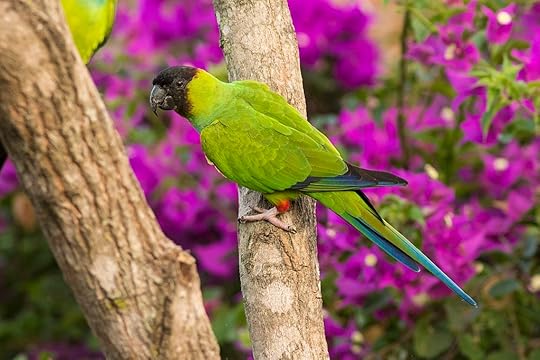 Nanday ParakeetPhoto credit: Alex SatsukawaLoraKim is now in Honduras and Guatemala for the month of October and then off to Guyana for much of November. While she is gone, we will be focusing on her thoughts (and mine) on why parrots are so much more than beautiful (even as we admire their physical beauty!).Last week just got away from me, so I’m blogging today about both the fourth and fifth parrots on LoraKim’s list of the world’s most beautiful parrots. They are the Nanday Parakeet and the Hyacinth Macaw (a favorite of mine!). Here’s what she has to say about each of these.The Nanday Parakeet: Many might not consider this bird beautiful, but they take my breath away. I think this is mostly because I lived with one, Exodor, in my home for 24 years and loved him fiercely. Now that I work with them in the wild, they seem so very amazing, mostly because they fuss and chatter seemingly constantly in their social groups, reminding me of the high energy of my beloved Nanday. Also, their matching red boots (red feathers around the ankles) coordinating with their red-encircled cloaca is so very dashing. I got a tattoo of these red feathers on my body in the same place as theirs to honor Exodor and this species (Located on the ankle, not the other location!)
Nanday ParakeetPhoto credit: Alex SatsukawaLoraKim is now in Honduras and Guatemala for the month of October and then off to Guyana for much of November. While she is gone, we will be focusing on her thoughts (and mine) on why parrots are so much more than beautiful (even as we admire their physical beauty!).Last week just got away from me, so I’m blogging today about both the fourth and fifth parrots on LoraKim’s list of the world’s most beautiful parrots. They are the Nanday Parakeet and the Hyacinth Macaw (a favorite of mine!). Here’s what she has to say about each of these.The Nanday Parakeet: Many might not consider this bird beautiful, but they take my breath away. I think this is mostly because I lived with one, Exodor, in my home for 24 years and loved him fiercely. Now that I work with them in the wild, they seem so very amazing, mostly because they fuss and chatter seemingly constantly in their social groups, reminding me of the high energy of my beloved Nanday. Also, their matching red boots (red feathers around the ankles) coordinating with their red-encircled cloaca is so very dashing. I got a tattoo of these red feathers on my body in the same place as theirs to honor Exodor and this species (Located on the ankle, not the other location!)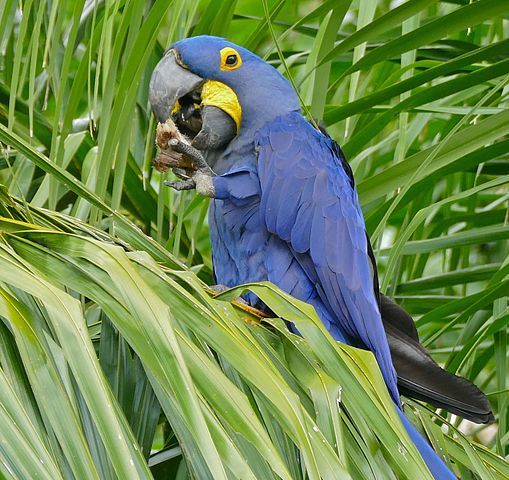 Hyacinth MacawPhoto credit: Bernard Dupont from France.This image was originally posted to Flickr by berniedup at https://flickr.com/photos/65695019@N07/28980194255The Hyacinth Macaw: I am guessing that this largest of all parrots, which is endangered in the wild, will make the top ten of many people. It is so blue, which contrasts with the yellow on the face to make the bird and its size just wrap around your heart. What I find especially beautiful though, is their behavior in the wild. They just move differently from other macaws, such as their regular foraging on the ground. They also seem to interact with their mates with behavior patterns that seem to project human awareness and appears to have a high amount of play and intimacy. Maybe these behaviors are also seen in other macaws, but a wild Hyacinth’s calmness makes it easier for humans to observe them, and to love them.The List:Yellow-naped amazonScarlet macawYellow-faced parrotNanday ParakeetHyacinth MacawPacfic ParakeetYellow-chevroned ParakeetSun ParakeetAustralian BudgerigarCarolina ParakeetHeracles inexpectatus
Hyacinth MacawPhoto credit: Bernard Dupont from France.This image was originally posted to Flickr by berniedup at https://flickr.com/photos/65695019@N07/28980194255The Hyacinth Macaw: I am guessing that this largest of all parrots, which is endangered in the wild, will make the top ten of many people. It is so blue, which contrasts with the yellow on the face to make the bird and its size just wrap around your heart. What I find especially beautiful though, is their behavior in the wild. They just move differently from other macaws, such as their regular foraging on the ground. They also seem to interact with their mates with behavior patterns that seem to project human awareness and appears to have a high amount of play and intimacy. Maybe these behaviors are also seen in other macaws, but a wild Hyacinth’s calmness makes it easier for humans to observe them, and to love them.The List:Yellow-naped amazonScarlet macawYellow-faced parrotNanday ParakeetHyacinth MacawPacfic ParakeetYellow-chevroned ParakeetSun ParakeetAustralian BudgerigarCarolina ParakeetHeracles inexpectatus
Published on November 12, 2019 14:45
November 5, 2019
Save a Species by Failing, and Admitting It
 This past week I attended the SMBC (Mesoamerican Society of Biology and Conservation) Parrot Symposium in Antigua Guatemala. One of my presentations was, “Scaling Up By Scaling Down: Conservation in Guatemala.” I referred to a recent research article which concluded that the greatest cause of conservation project failure was interpersonal relations, not external factors like politics, corruption, and violence, which are rampant in Central America socioeconomic landscapes. My conclusion was that if we wanted to grow our conservation projects we had to “scale down” and pay attention to building social capital within our team members and participating organizations and communities.
This past week I attended the SMBC (Mesoamerican Society of Biology and Conservation) Parrot Symposium in Antigua Guatemala. One of my presentations was, “Scaling Up By Scaling Down: Conservation in Guatemala.” I referred to a recent research article which concluded that the greatest cause of conservation project failure was interpersonal relations, not external factors like politics, corruption, and violence, which are rampant in Central America socioeconomic landscapes. My conclusion was that if we wanted to grow our conservation projects we had to “scale down” and pay attention to building social capital within our team members and participating organizations and communities. The bright side of these causes of failures is that we can learn and improve our interpersonal relations, while we might not otherwise have much control over lack of funding, climate change, poverty, or other negative impacts on conservation efforts. But we can’t learn, as this study surmised, if we don’t admit our failures, publically, and learn from them, individually and as a group and coalition of activists.So my presentation continued with me admitting to a major failed project in Guatemala during the 1990s, the agonizing details which can be found in my quite public memoir, "Conservation in a Time of War.” But I learned much from the loss of so many birds, habitats, and frankly, hope and energy for many years. I knew that I needed to find a way to improve both my relations with others, with myself, and with other species. This way I could address the leading causes of project failures as found in this study: problematic interactions between people, lack of trust, negative experiences with past conservation initiatives, and inefficient communication.
The bright side of these causes of failures is that we can learn and improve our interpersonal relations, while we might not otherwise have much control over lack of funding, climate change, poverty, or other negative impacts on conservation efforts. But we can’t learn, as this study surmised, if we don’t admit our failures, publically, and learn from them, individually and as a group and coalition of activists.So my presentation continued with me admitting to a major failed project in Guatemala during the 1990s, the agonizing details which can be found in my quite public memoir, "Conservation in a Time of War.” But I learned much from the loss of so many birds, habitats, and frankly, hope and energy for many years. I knew that I needed to find a way to improve both my relations with others, with myself, and with other species. This way I could address the leading causes of project failures as found in this study: problematic interactions between people, lack of trust, negative experiences with past conservation initiatives, and inefficient communication. How do we address these problems? One Earth Conservation guides others to develop relationships through our Nurture Nature Program, of which our latest book, “Nurturing Discussions and Practices,” is a major part of.
How do we address these problems? One Earth Conservation guides others to develop relationships through our Nurture Nature Program, of which our latest book, “Nurturing Discussions and Practices,” is a major part of. Parrot conservationists at the SMBC Parrot ConferenceI leaned on another way of growing relationships this week by attending this conference. By spending an entire day with fellow parrot conservationists, learning and adjusting our collected efforts towards a stronger conservation stand, I found new friends and seeds for future work. There is nothing like face-to-face meetings, time, and a slowed down schedule to inspire trust and facilitate communication.So thank you dear fellow parrot conservationists, which include all our donors, and readers of this blog. Fail forward ho!
Parrot conservationists at the SMBC Parrot ConferenceI leaned on another way of growing relationships this week by attending this conference. By spending an entire day with fellow parrot conservationists, learning and adjusting our collected efforts towards a stronger conservation stand, I found new friends and seeds for future work. There is nothing like face-to-face meetings, time, and a slowed down schedule to inspire trust and facilitate communication.So thank you dear fellow parrot conservationists, which include all our donors, and readers of this blog. Fail forward ho!
Published on November 05, 2019 07:45
October 29, 2019
Beauty with a Yellow Face
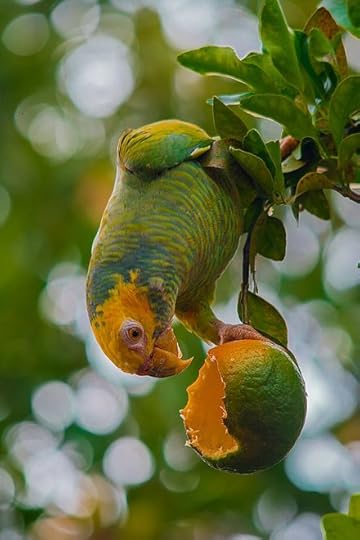 LoraKim is now in Honduras and Guatemala for the month of October and then off to Guyana for much of November. While she is gone, we will be focusing on her thoughts (and mine) on why parrots are so much more than beautiful (even as we admire their physical beauty!).Let’s talk, today, about the third bird on LoraKim Joyner’s list of the most beautiful parrots, which is the yellow-faced parrot (I’ve included the full list at the end of this blog in case you haven’t seen it already and are curious).This species is found in South America, including in the countries of Brazil, Bolivia, and, where One Earth Conservation works, Paraguay. The conservation status of the yellow-faced parrot is “Near Threatened,” mostly due to habitat loss. Theirs is an unusual habitat, as the birds nest in hollow termitaria (termite nests consisting of a mound of earth), and many ranches in areas where the birds live clear away the termitaria to plant pasture grass for cattle. Some of these parrots are also being taken for the illegal wildlife trade, which further decreases their numbers in the wild.
LoraKim is now in Honduras and Guatemala for the month of October and then off to Guyana for much of November. While she is gone, we will be focusing on her thoughts (and mine) on why parrots are so much more than beautiful (even as we admire their physical beauty!).Let’s talk, today, about the third bird on LoraKim Joyner’s list of the most beautiful parrots, which is the yellow-faced parrot (I’ve included the full list at the end of this blog in case you haven’t seen it already and are curious).This species is found in South America, including in the countries of Brazil, Bolivia, and, where One Earth Conservation works, Paraguay. The conservation status of the yellow-faced parrot is “Near Threatened,” mostly due to habitat loss. Theirs is an unusual habitat, as the birds nest in hollow termitaria (termite nests consisting of a mound of earth), and many ranches in areas where the birds live clear away the termitaria to plant pasture grass for cattle. Some of these parrots are also being taken for the illegal wildlife trade, which further decreases their numbers in the wild. One Earth Conservation is working closely with local people in Paraguay to protect the yellow-faced parrots who live there, as well as their nests, and to track their numbers. This includes some ranch owners who have become concerned about the decreasing numbers of parrots and who want to help.Here’s what LoraKim has to say about the yellow-faced parrot, “I have described how appreciating beauty comes about from experiencing birds directly and empathizing with them over a long time. It also arises from the commitment to conserve them that deepens appreciation, respect, and wonder of the birds, and the beautiful perseverance of the teams that work together to save these birds. Beauty, and its companion, wonder and awe, also come about because of a bird’s rarity or uniqueness. This species strikes me as beautiful because I know so little about it and it seems strange to me. They nest in termitaria in the ground, they have natural color variations in the wild with striking amounts of yellow and red on their abdomen, and they lose feathers around their nares. They also seem to be migratory in part, highly sociable as they move about in flocks, and mix with A. aestiva in these flocks, and with them and A. amazonica in roost sites. Just this past week I saw a pair of them mating low in a tree as they uttered unseemly calls for any parrot, and then watched as the female flew to the termitaria with a cow grazing just a few meters away, and slowly back in, tail-first, into her termitaria nest for the night. What is more beautiful than that?”The List:Yellow-naped amazonScarlet macawYellow-faced parrotNanday ParakeetHyacinth MacawPacfic ParakeetYellow-chevroned ParakeetSun ParakeetAustralian BudgerigarCarolina ParakeetHeracles inexpectatus
One Earth Conservation is working closely with local people in Paraguay to protect the yellow-faced parrots who live there, as well as their nests, and to track their numbers. This includes some ranch owners who have become concerned about the decreasing numbers of parrots and who want to help.Here’s what LoraKim has to say about the yellow-faced parrot, “I have described how appreciating beauty comes about from experiencing birds directly and empathizing with them over a long time. It also arises from the commitment to conserve them that deepens appreciation, respect, and wonder of the birds, and the beautiful perseverance of the teams that work together to save these birds. Beauty, and its companion, wonder and awe, also come about because of a bird’s rarity or uniqueness. This species strikes me as beautiful because I know so little about it and it seems strange to me. They nest in termitaria in the ground, they have natural color variations in the wild with striking amounts of yellow and red on their abdomen, and they lose feathers around their nares. They also seem to be migratory in part, highly sociable as they move about in flocks, and mix with A. aestiva in these flocks, and with them and A. amazonica in roost sites. Just this past week I saw a pair of them mating low in a tree as they uttered unseemly calls for any parrot, and then watched as the female flew to the termitaria with a cow grazing just a few meters away, and slowly back in, tail-first, into her termitaria nest for the night. What is more beautiful than that?”The List:Yellow-naped amazonScarlet macawYellow-faced parrotNanday ParakeetHyacinth MacawPacfic ParakeetYellow-chevroned ParakeetSun ParakeetAustralian BudgerigarCarolina ParakeetHeracles inexpectatus
Published on October 29, 2019 08:17
October 23, 2019
The List
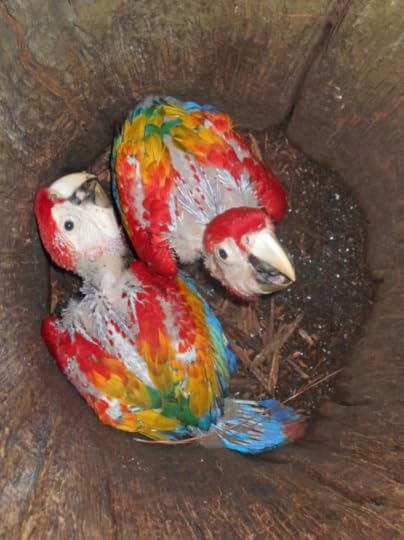 Young scarlet macaws in their nestLoraKim is now in Honduras and Guatemala for the month of October and then off to Guyana for much of November. While she is gone, we will be focusing on her thoughts (and mine) on why parrots are so much more than beautiful (even as we admire their physical beauty!).Due to “popular demand,” I am providing our readers with LoraKim’s list of which parrot species (living and extinct) she considers the most beautiful, with the caveat that both she and I really think ALL parrots, in fact all living things, are beautiful. With that said, here’s her list:Yellow-naped amazonScarlet macawYellow-faced parrotNanday ParakeetHyacinth MacawPacfic ParakeetYellow-chevroned ParakeetSun ParakeetAustralian BudgerigarCarolina ParakeetHeracles inexpectatus
Young scarlet macaws in their nestLoraKim is now in Honduras and Guatemala for the month of October and then off to Guyana for much of November. While she is gone, we will be focusing on her thoughts (and mine) on why parrots are so much more than beautiful (even as we admire their physical beauty!).Due to “popular demand,” I am providing our readers with LoraKim’s list of which parrot species (living and extinct) she considers the most beautiful, with the caveat that both she and I really think ALL parrots, in fact all living things, are beautiful. With that said, here’s her list:Yellow-naped amazonScarlet macawYellow-faced parrotNanday ParakeetHyacinth MacawPacfic ParakeetYellow-chevroned ParakeetSun ParakeetAustralian BudgerigarCarolina ParakeetHeracles inexpectatus We’ve already focused a bit on the yellow-naped amazon (see last week’s blog). Here are LoraKim’s thoughts on the scarlet macaw:“I only recently started to work with wild scarlet macaws, starting in 2009. I wasn’t initially very attracted to them, because of my past emphasis on the yellow-naped amazon. True the colors are incredible, but it was only when I started studying the nests and chicks, and protecting the nests, did their beauty grow on me. When I see these parrots, I am not only reminded of how special the birds are, but the powerful commitment of the people I work with who protect them. So, the beauty of both human and parrot are woven together in my appreciation of this bird, so much so that I got a tattoo of the brightly mixed colors of their shoulder feathers placed onto my own shoulder. I touch it regularly as a reminder of their worth and beauty, and to instill focus and connection so that I might continue my work for them in the world.”Stay tuned as we work our way down the list over the coming weeks!
We’ve already focused a bit on the yellow-naped amazon (see last week’s blog). Here are LoraKim’s thoughts on the scarlet macaw:“I only recently started to work with wild scarlet macaws, starting in 2009. I wasn’t initially very attracted to them, because of my past emphasis on the yellow-naped amazon. True the colors are incredible, but it was only when I started studying the nests and chicks, and protecting the nests, did their beauty grow on me. When I see these parrots, I am not only reminded of how special the birds are, but the powerful commitment of the people I work with who protect them. So, the beauty of both human and parrot are woven together in my appreciation of this bird, so much so that I got a tattoo of the brightly mixed colors of their shoulder feathers placed onto my own shoulder. I touch it regularly as a reminder of their worth and beauty, and to instill focus and connection so that I might continue my work for them in the world.”Stay tuned as we work our way down the list over the coming weeks!
Published on October 23, 2019 07:46
October 15, 2019
Beauty is More Than Feather Deep
 LoraKim is now in Honduras and Guatemala for the month of October and then off to Guyana for much of November. While she is gone, we will be focusing on her thoughts (and mine) on why parrots are so much more than beautiful (even as we admire their physical beauty!).This fall One Earth Conservation is focusing on why parrots are so much more than beautiful. This focus was in part inspired by a list that LoraKim Joyner was asked to make (for an interview) of which parrot species she thinks are the most beautiful. While she is doing a lot of traveling in October and November, let's take a look at which species she chose and why. The first on the list is the yellow-naped amazon and here are her thoughts:“It’s often the case for me that the more I get to know an individual (human or otherwise) I discover more and more ways that they are unique and beautiful. Given how much time I have spent with this species, I have witnessed the many ways that these birds in the wild have displayed remarkable behavior and color variations and vibrancy. I have studied them from eggs until old age. I even changed my name to LoraKim (the Lora means amazon parrot in Spanish and Kim is my given name) in honor of them. When I hear their calls and see them flying, it’s as if my heart soars, and I am reminded of how beauty is all around, actually.”
LoraKim is now in Honduras and Guatemala for the month of October and then off to Guyana for much of November. While she is gone, we will be focusing on her thoughts (and mine) on why parrots are so much more than beautiful (even as we admire their physical beauty!).This fall One Earth Conservation is focusing on why parrots are so much more than beautiful. This focus was in part inspired by a list that LoraKim Joyner was asked to make (for an interview) of which parrot species she thinks are the most beautiful. While she is doing a lot of traveling in October and November, let's take a look at which species she chose and why. The first on the list is the yellow-naped amazon and here are her thoughts:“It’s often the case for me that the more I get to know an individual (human or otherwise) I discover more and more ways that they are unique and beautiful. Given how much time I have spent with this species, I have witnessed the many ways that these birds in the wild have displayed remarkable behavior and color variations and vibrancy. I have studied them from eggs until old age. I even changed my name to LoraKim (the Lora means amazon parrot in Spanish and Kim is my given name) in honor of them. When I hear their calls and see them flying, it’s as if my heart soars, and I am reminded of how beauty is all around, actually.”
Published on October 15, 2019 07:41
October 1, 2019
Saving the Earth by Becoming Animal
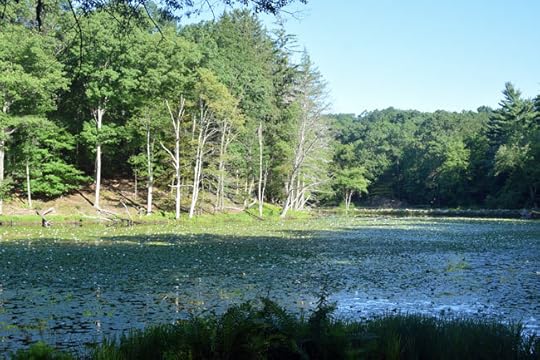 Mountain Lakes Park, NY last monthLast weekend I was out camping in mid-state New York with my spouse. We walked along the ancient trails that had once been traveled by indigenous people, and then colonialists from Europe who began “buying” the land here in the early 1600s. Even to my unpracticed eye for Northeastern woodlands, the woods seemed barren, stripped of biodiversity, perhaps in part because our migrant birds were now heading south. But where was everyone else? “Where were the squirrels?” I asked my spouse. We saw plenty of people walking their dogs, off leash for the most part, and certainly against park rules. I am all for dogs enjoying themselves and doing what dogs do, but I know many are hunters and can harm wildlife. Were they the cause I mused as we hiked? Or was it the general loss of biodiversity that is putting all life on earth at risk? The devastating loss of bird life in North America due to human causes? The climate crisis? Such speculation does little to offset the normally soothing experience of a walk in the woods.
Mountain Lakes Park, NY last monthLast weekend I was out camping in mid-state New York with my spouse. We walked along the ancient trails that had once been traveled by indigenous people, and then colonialists from Europe who began “buying” the land here in the early 1600s. Even to my unpracticed eye for Northeastern woodlands, the woods seemed barren, stripped of biodiversity, perhaps in part because our migrant birds were now heading south. But where was everyone else? “Where were the squirrels?” I asked my spouse. We saw plenty of people walking their dogs, off leash for the most part, and certainly against park rules. I am all for dogs enjoying themselves and doing what dogs do, but I know many are hunters and can harm wildlife. Were they the cause I mused as we hiked? Or was it the general loss of biodiversity that is putting all life on earth at risk? The devastating loss of bird life in North America due to human causes? The climate crisis? Such speculation does little to offset the normally soothing experience of a walk in the woods. Our campsite in between hiking showing spouse Meredith GarmonWhen I got home, I reviewed some of literature, and specifically the impact of people and dogs in nature. People along trails do displace wildlife, but people with dogs do even more so:“A single hiker walking down a trail causes wildlife displacement of 150 feet. But a hiker with a dog on leash results in a wildlife displacement of 280 feet in one direction. When the panoramic radius on both sides of the trail is combined to create total diameter, it means a zone of 560 feet. It’s one thing if the displacement causes an animal to flee and it is able to return to its preferred habitat after the person and dog are gone, but the disruption can become chronic, if not permanent, when the trail receives a stream of near-constant or heavy use."
Our campsite in between hiking showing spouse Meredith GarmonWhen I got home, I reviewed some of literature, and specifically the impact of people and dogs in nature. People along trails do displace wildlife, but people with dogs do even more so:“A single hiker walking down a trail causes wildlife displacement of 150 feet. But a hiker with a dog on leash results in a wildlife displacement of 280 feet in one direction. When the panoramic radius on both sides of the trail is combined to create total diameter, it means a zone of 560 feet. It’s one thing if the displacement causes an animal to flee and it is able to return to its preferred habitat after the person and dog are gone, but the disruption can become chronic, if not permanent, when the trail receives a stream of near-constant or heavy use." So even when we taking care of ourselves and our dogs, we are causing harm. There seems to be no escaping this hard reality that humans are driving the 6th great extinction.Recent dire reports about the “end of nature” seemed to have resulted in a plethora of organizations and programs aimed at the transformation of humanity that is necessary to offset our negative impact. This transformation occurs not just in behavioral and policy changes, but must also in our inner life. We may not be able to do the hard things to curtail human consumption if we don’t cease from seeing ourselves as separate from other beings and as having more privilege and rights than other species.
So even when we taking care of ourselves and our dogs, we are causing harm. There seems to be no escaping this hard reality that humans are driving the 6th great extinction.Recent dire reports about the “end of nature” seemed to have resulted in a plethora of organizations and programs aimed at the transformation of humanity that is necessary to offset our negative impact. This transformation occurs not just in behavioral and policy changes, but must also in our inner life. We may not be able to do the hard things to curtail human consumption if we don’t cease from seeing ourselves as separate from other beings and as having more privilege and rights than other species. (Photo by Andrew - https://www.flickr.com/photos/nez/118... what will motivate that inner transformation? Experiencing and imagining catastrophic loss is a motivator, but it might not be enough. At least it isn’t for me on most days, as I mourn the depletion of abundance and vibrancy in the nonhuman world. We need to know how to decenter ourselves in the web of life while also more firmly knitting our connections to all others.Simon Leadbeatersummarizes the importance of this workto end the threat of human caused extinction, and a suggested path for doing so, by drawing citing John Berkman:"Berkman recommended moving away from general statements of avoiding suffering to focusing on the needs of individuals and suggested we all should become ‘theological ethologists’ (Berkman 2017). So, in short, it is not enough to think in terms of conservation, we need to create happiness. What are the indices of happiness for wild-living animals?" Berkman describes theological ethology as, “the discipline that seeks to understand each species in light of its own authentic natural [and supernatural] good…. understood as flourishing according to its nature.” I myself don’t find the use of the word, “supernatural,” necessary in understanding this work that we need to do, because there is no "super" or hierarchy. All things divine and sacred are in nature, and are nature.
(Photo by Andrew - https://www.flickr.com/photos/nez/118... what will motivate that inner transformation? Experiencing and imagining catastrophic loss is a motivator, but it might not be enough. At least it isn’t for me on most days, as I mourn the depletion of abundance and vibrancy in the nonhuman world. We need to know how to decenter ourselves in the web of life while also more firmly knitting our connections to all others.Simon Leadbeatersummarizes the importance of this workto end the threat of human caused extinction, and a suggested path for doing so, by drawing citing John Berkman:"Berkman recommended moving away from general statements of avoiding suffering to focusing on the needs of individuals and suggested we all should become ‘theological ethologists’ (Berkman 2017). So, in short, it is not enough to think in terms of conservation, we need to create happiness. What are the indices of happiness for wild-living animals?" Berkman describes theological ethology as, “the discipline that seeks to understand each species in light of its own authentic natural [and supernatural] good…. understood as flourishing according to its nature.” I myself don’t find the use of the word, “supernatural,” necessary in understanding this work that we need to do, because there is no "super" or hierarchy. All things divine and sacred are in nature, and are nature. Regardless of your theological leanings, One Earth Conservation published a nonsectarian and largely scientific and spiritual guide book, “Nurturing Discussions and Practices: Nurturing Yourself, Relationships, and Nature,” that is basically a manual on “ethology theology.” Oriented on language and practices that emphasizes the feelings and needs that crosses species lines, this book leads the practitioner to a rewiring of the brain, over time, and perhaps even suddenly. We see humans as animals, thriving in nature, and not apart from it. Through practice and studying of animal behavior, which is known as ethology, we grow our multispecies intelligence. We end up seeing the interconnections of beauty and tragedy connecting us to everything by learning about the behavior and motivations of ourselves and other species. We accept the animality of our humanity, and vow to change our behavior. By doing so we feel more welcomed on this planet, and more welcoming.However you take up the work of loving yourself as your neighbor, of all species, do it now, urgently, so we can choose to not end a flourishing and vibrant nature, but to end our sense of separation from it.As we walk more peacefully along our life’s paths, the wildlife will return.
Regardless of your theological leanings, One Earth Conservation published a nonsectarian and largely scientific and spiritual guide book, “Nurturing Discussions and Practices: Nurturing Yourself, Relationships, and Nature,” that is basically a manual on “ethology theology.” Oriented on language and practices that emphasizes the feelings and needs that crosses species lines, this book leads the practitioner to a rewiring of the brain, over time, and perhaps even suddenly. We see humans as animals, thriving in nature, and not apart from it. Through practice and studying of animal behavior, which is known as ethology, we grow our multispecies intelligence. We end up seeing the interconnections of beauty and tragedy connecting us to everything by learning about the behavior and motivations of ourselves and other species. We accept the animality of our humanity, and vow to change our behavior. By doing so we feel more welcomed on this planet, and more welcoming.However you take up the work of loving yourself as your neighbor, of all species, do it now, urgently, so we can choose to not end a flourishing and vibrant nature, but to end our sense of separation from it.As we walk more peacefully along our life’s paths, the wildlife will return.
Published on October 01, 2019 07:03
September 24, 2019
Parrots, Poems, Prayers, and Promises
I've been lately thinking about birds' lifetimes All the things not done and how they've been And I can't help believing in their own mind I know I'm gonna hate to see them end....And talk of poems and prayers and promises and things that we believe in How sweet it is to love the birds how right it is to care How long it's been since yesterday what about tomorrow And what about our dreams and all the memories we share..I have to ask it now, it's been a good life not for all?(adapted from John Denver's "Poems, Prayers, and Promises."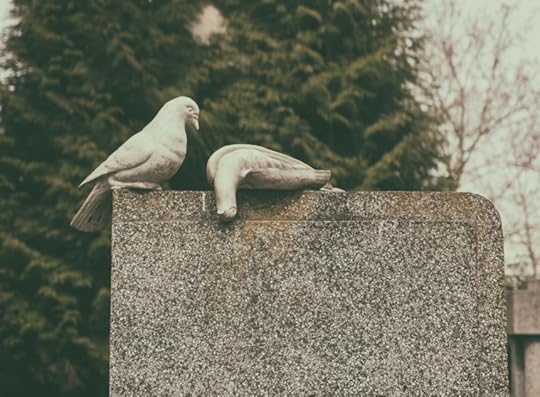 A little over a month ago I wrote about how counting parrots as part of our population monitoring efforts was like a prayer for me. I asked them to take me with them, wherever they were going as they soared beautifully by.Well, they may indeed take humans with them. Their disappearing numbers harbor our own as we consider the consequences of climate change and loss of biodiversity. Last week a study was published in the journal Science reporting that in North America, we have lost nearly 3 billion birds, which is one in four.Now cognitively I have know this, it is my life's work. But to see it splashed across several headlines and have my suspicions so publicly confirmed, I wept. The birds to whom I prayed for when I was a child are vanishing. One commentator says it is "the end of nature."If this is so, let us mourn together. Through our grief we shall learn what love for all life is, and maybe, just maybe, promise to care for the feathered ones we believe in.This weekend there is a chance to mourn, love, and promise together. Please join us at Green-Wood Cemetery in Brooklyn, NY to admire the soaring and chattering parrots that live there, as well as to hear poems, prayers, and promises. Go here for more information and to get tickets.
A little over a month ago I wrote about how counting parrots as part of our population monitoring efforts was like a prayer for me. I asked them to take me with them, wherever they were going as they soared beautifully by.Well, they may indeed take humans with them. Their disappearing numbers harbor our own as we consider the consequences of climate change and loss of biodiversity. Last week a study was published in the journal Science reporting that in North America, we have lost nearly 3 billion birds, which is one in four.Now cognitively I have know this, it is my life's work. But to see it splashed across several headlines and have my suspicions so publicly confirmed, I wept. The birds to whom I prayed for when I was a child are vanishing. One commentator says it is "the end of nature."If this is so, let us mourn together. Through our grief we shall learn what love for all life is, and maybe, just maybe, promise to care for the feathered ones we believe in.This weekend there is a chance to mourn, love, and promise together. Please join us at Green-Wood Cemetery in Brooklyn, NY to admire the soaring and chattering parrots that live there, as well as to hear poems, prayers, and promises. Go here for more information and to get tickets.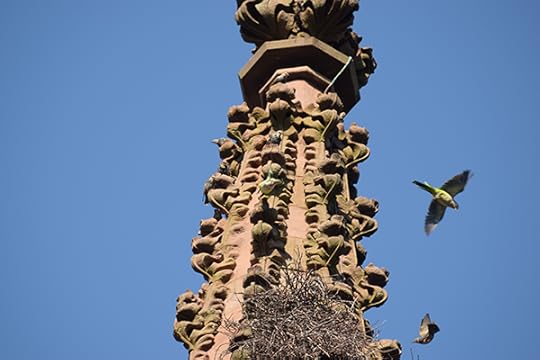 Parrots at Green-Wood Cemetery
Parrots at Green-Wood Cemetery
 A little over a month ago I wrote about how counting parrots as part of our population monitoring efforts was like a prayer for me. I asked them to take me with them, wherever they were going as they soared beautifully by.Well, they may indeed take humans with them. Their disappearing numbers harbor our own as we consider the consequences of climate change and loss of biodiversity. Last week a study was published in the journal Science reporting that in North America, we have lost nearly 3 billion birds, which is one in four.Now cognitively I have know this, it is my life's work. But to see it splashed across several headlines and have my suspicions so publicly confirmed, I wept. The birds to whom I prayed for when I was a child are vanishing. One commentator says it is "the end of nature."If this is so, let us mourn together. Through our grief we shall learn what love for all life is, and maybe, just maybe, promise to care for the feathered ones we believe in.This weekend there is a chance to mourn, love, and promise together. Please join us at Green-Wood Cemetery in Brooklyn, NY to admire the soaring and chattering parrots that live there, as well as to hear poems, prayers, and promises. Go here for more information and to get tickets.
A little over a month ago I wrote about how counting parrots as part of our population monitoring efforts was like a prayer for me. I asked them to take me with them, wherever they were going as they soared beautifully by.Well, they may indeed take humans with them. Their disappearing numbers harbor our own as we consider the consequences of climate change and loss of biodiversity. Last week a study was published in the journal Science reporting that in North America, we have lost nearly 3 billion birds, which is one in four.Now cognitively I have know this, it is my life's work. But to see it splashed across several headlines and have my suspicions so publicly confirmed, I wept. The birds to whom I prayed for when I was a child are vanishing. One commentator says it is "the end of nature."If this is so, let us mourn together. Through our grief we shall learn what love for all life is, and maybe, just maybe, promise to care for the feathered ones we believe in.This weekend there is a chance to mourn, love, and promise together. Please join us at Green-Wood Cemetery in Brooklyn, NY to admire the soaring and chattering parrots that live there, as well as to hear poems, prayers, and promises. Go here for more information and to get tickets. Parrots at Green-Wood Cemetery
Parrots at Green-Wood Cemetery
Published on September 24, 2019 13:47
September 18, 2019
Termites and the Endangered Yellow-faced Parrots of Paraguay
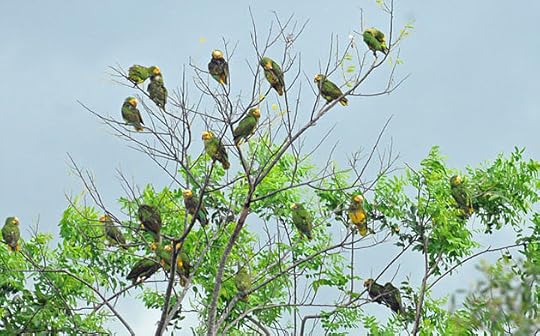 Flock of yellow-faced parrots in Paraguay showing various amounts of yellow and red on their abdomensRising up from the pasture and scrub, termite mounds dot the Paraguayan landscapes. They are home to not only the termites which build them, but a host of animals, including the yellow-faced parrot that we are studying and protecting.
Flock of yellow-faced parrots in Paraguay showing various amounts of yellow and red on their abdomensRising up from the pasture and scrub, termite mounds dot the Paraguayan landscapes. They are home to not only the termites which build them, but a host of animals, including the yellow-faced parrot that we are studying and protecting. 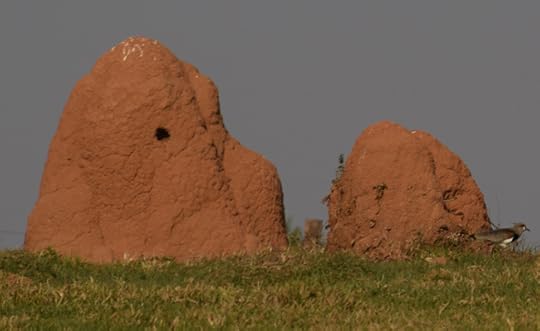 Termite mounds abound, as do lapwings!
Termite mounds abound, as do lapwings! Southern tamandua (lesser anteater) resting during the hot day in one termite mound we inspected (photo by Dr. Andres Alvarez)Not much is known about this unusual bird, which shows color variation that doesn’t seem to have anything to do with sex or age. They also have feather loss on the face around the nares and upper beak – and no one knows why. They are highly social, congregating in low-flying flocks throughout the year, sometimes mixed with young turquoise-fronted amazon parrots. They also sleep in the same roost area with turquoise-fronted parrots as well as orange-winged parrots. Pairs do split off from these flocks during breeding season, and it is these couples that we are in search of so that we can register their nests, and protect them.
Southern tamandua (lesser anteater) resting during the hot day in one termite mound we inspected (photo by Dr. Andres Alvarez)Not much is known about this unusual bird, which shows color variation that doesn’t seem to have anything to do with sex or age. They also have feather loss on the face around the nares and upper beak – and no one knows why. They are highly social, congregating in low-flying flocks throughout the year, sometimes mixed with young turquoise-fronted amazon parrots. They also sleep in the same roost area with turquoise-fronted parrots as well as orange-winged parrots. Pairs do split off from these flocks during breeding season, and it is these couples that we are in search of so that we can register their nests, and protect them.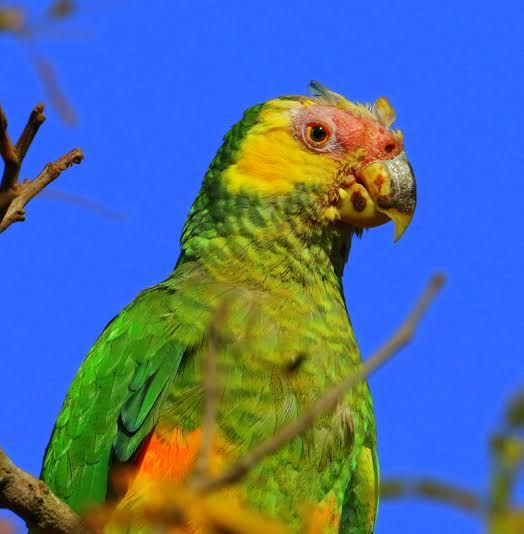 Feather loss around the face of a this parrot
Feather loss around the face of a this parrot Ranch hand showing Dr. Andres Alvarez a parrot nest in a termite moundTo register nests, the quickest method is to ask the local ranch hand to show us suspect nests. This serves doubly to let the ranch hand know that the birds matter, and that if the chicks go missing, we know that ranch employees were aware of the nest, and could be the suspected nest robbers. Usually though the ranch hands are more interested in their work with cattle, and enjoy showing us their fields and byways. Having the ranch hands show us where nests are saves us a lot of time, though we can’t take just the word of the cowboy. We have to confirm the nests because birds could enter a termite mound without it being an active nest, or the nest could have failed or been predated.Often ranch hands don’t go everywhere where nests could be, or haven’t been observant, so we have to start from scratch. First we look for pairs acting like they are defending a territory or are in reproductive mode, which means a male feeding a female or the pair copulating. As this species doesn’t seem as territorial as others, that is, they don’t call loudly at the edges of their territory or chase birds away much, it can be hard to track them down to a possible termite mound.
Ranch hand showing Dr. Andres Alvarez a parrot nest in a termite moundTo register nests, the quickest method is to ask the local ranch hand to show us suspect nests. This serves doubly to let the ranch hand know that the birds matter, and that if the chicks go missing, we know that ranch employees were aware of the nest, and could be the suspected nest robbers. Usually though the ranch hands are more interested in their work with cattle, and enjoy showing us their fields and byways. Having the ranch hands show us where nests are saves us a lot of time, though we can’t take just the word of the cowboy. We have to confirm the nests because birds could enter a termite mound without it being an active nest, or the nest could have failed or been predated.Often ranch hands don’t go everywhere where nests could be, or haven’t been observant, so we have to start from scratch. First we look for pairs acting like they are defending a territory or are in reproductive mode, which means a male feeding a female or the pair copulating. As this species doesn’t seem as territorial as others, that is, they don’t call loudly at the edges of their territory or chase birds away much, it can be hard to track them down to a possible termite mound.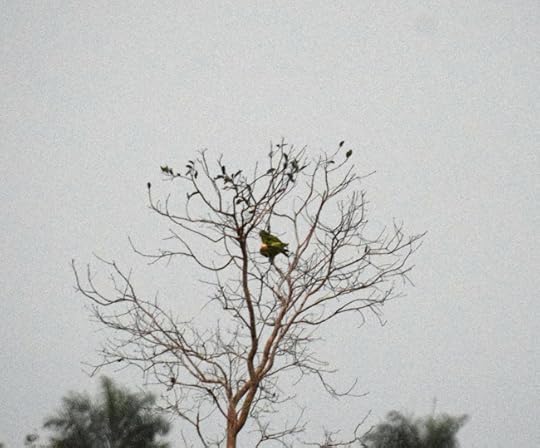 Pair caught mating near a row of termite mounds. Poor quality of the picture highlights how far away we have to be and the often poor light of pre-sunrise and post-sunset.
Pair caught mating near a row of termite mounds. Poor quality of the picture highlights how far away we have to be and the often poor light of pre-sunrise and post-sunset. A yellow-faced parrot was seen on this mound a lot one evening, but might have only been using it for a perchI watched one mound in August 2019 to confirm it as a nest, and was heartened to see and hear birds mating, and the male feeding a female nearby. This was all very suspicious of an active nest, and thought I had struck gold. But the nest watch was just beginning. I would have to observe the female entering the cavity and spending the night. Unless the female enters the cavity to spend the night, meaning she likely has eggs or small chicks, we can’t be sure it is a nest. The challenge is that the birds can approach the nest site quietly, enter when it is nearly dark, seem to know when you are looking directly at them, and if they are in the mound when you approach, they often sit tight and you don’t know they are there. One has to be as sneaky as the birds, not moving a muscle as the mosquitoes descend, or even when the field’s bull approaches you with apparent alarm, which is mutually shared. Finally, at near dark, I had burrowed myself deep enough into the scrub and cow patties, and been still enough that the female entered the cavity.
A yellow-faced parrot was seen on this mound a lot one evening, but might have only been using it for a perchI watched one mound in August 2019 to confirm it as a nest, and was heartened to see and hear birds mating, and the male feeding a female nearby. This was all very suspicious of an active nest, and thought I had struck gold. But the nest watch was just beginning. I would have to observe the female entering the cavity and spending the night. Unless the female enters the cavity to spend the night, meaning she likely has eggs or small chicks, we can’t be sure it is a nest. The challenge is that the birds can approach the nest site quietly, enter when it is nearly dark, seem to know when you are looking directly at them, and if they are in the mound when you approach, they often sit tight and you don’t know they are there. One has to be as sneaky as the birds, not moving a muscle as the mosquitoes descend, or even when the field’s bull approaches you with apparent alarm, which is mutually shared. Finally, at near dark, I had burrowed myself deep enough into the scrub and cow patties, and been still enough that the female entered the cavity. Me at nest watch described above, and curious cows come to keep me company during the observation period below.
Me at nest watch described above, and curious cows come to keep me company during the observation period below.
 Yellow-faced parrot in her termite mound nest. She didn't want to leave even though we were right above her taking pictures to confirm activity.
Yellow-faced parrot in her termite mound nest. She didn't want to leave even though we were right above her taking pictures to confirm activity. Chicks that hatched from nest showed in previous photo. However, the parents lost their three chicks to poachersSometimes though the female is less shy, such as the nest below confirmed and photographed by Dr. Andres Alvarez (below). He merely ducked behind a tree and the female entered!
Chicks that hatched from nest showed in previous photo. However, the parents lost their three chicks to poachersSometimes though the female is less shy, such as the nest below confirmed and photographed by Dr. Andres Alvarez (below). He merely ducked behind a tree and the female entered! Even if we see a female enter, we need to confirm that there are eggs or chicks inside. This means trying to find a way to see inside the mounds, which have curved entrances and deep cavities. We use small cameras, flash lights, and endoscopes (photos below). We never know what we are going to find, and a venomous snake is not out of the question. For this reason, we don’t use our hands to inspect a cavity.
Even if we see a female enter, we need to confirm that there are eggs or chicks inside. This means trying to find a way to see inside the mounds, which have curved entrances and deep cavities. We use small cameras, flash lights, and endoscopes (photos below). We never know what we are going to find, and a venomous snake is not out of the question. For this reason, we don’t use our hands to inspect a cavity.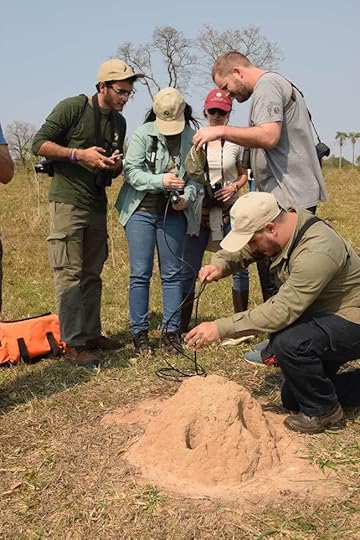
 Endoscope inspection camera (in photo above) doesn't yield good pictures, but does confirm the presence of parrot eggs. It's an active nest!
Endoscope inspection camera (in photo above) doesn't yield good pictures, but does confirm the presence of parrot eggs. It's an active nest! This is our first year for studying and protecting this species’ nests actively, so we are still learning methodology and biology, which we do because we need more information if we are to protect them. And protecting them we need to do. I was out doing a nest watch when a couple of guys stopped on a motorcycle and asked me if I wanted to buy parrots from them. They saw my binoculars and camera and assumed I had the means and desire to take birds from the wild. I politely declined with hand gestures, as Spanish was for both of us a second language. As they push-started their motorcycle down the dusty road I turned my attention back to the suspected nest, dreaming in the sun…that one day when those with power and privilege are spied out amongst the birds, that it will be assumed that it is to protect the people and the parrots of the land, and not to ravage them.
This is our first year for studying and protecting this species’ nests actively, so we are still learning methodology and biology, which we do because we need more information if we are to protect them. And protecting them we need to do. I was out doing a nest watch when a couple of guys stopped on a motorcycle and asked me if I wanted to buy parrots from them. They saw my binoculars and camera and assumed I had the means and desire to take birds from the wild. I politely declined with hand gestures, as Spanish was for both of us a second language. As they push-started their motorcycle down the dusty road I turned my attention back to the suspected nest, dreaming in the sun…that one day when those with power and privilege are spied out amongst the birds, that it will be assumed that it is to protect the people and the parrots of the land, and not to ravage them. Destroyed termite mound by poachers in search of parrots
Destroyed termite mound by poachers in search of parrots
Published on September 18, 2019 12:53
September 11, 2019
A Broken Earth: We Must Re-parrot (repair it)!
There has been great loss in parrot life and populations inflicted by humans. For thousands of years people have captured parrots for home and for trade. In recent decades, the harm has escalated to the point that more than a third of all parrot species (nearly 400) are endangered, over 50% have declining populations (that we know of), and entire native regions are devoid of species that humans favor. Habitat degradation compounds the problem. How are we going to replenish our parrot populations? Can we do it through reparations?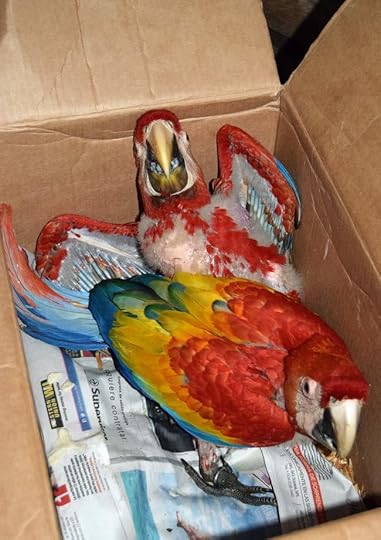 Scarred, rescued scarlet macaws in Honduras. They are now flying free, but just barely escaped a life captivityReparations is replenishment of a previously inflicted loss. Reparations in the human realm often come in the form of apologies, financial awards, and land, and have been awarded to indigenous people, Holocaust survivors, abused women, and those wrongfully imprisoned or harmed. Currently in North America we have a lively discussion now about reparations for African Americans who are descendants of slaves. Part of this process is deciding who "pays" for the loss and who gets "paid," especially if there are no living survivors.It is possible that governments can take responsibility to lead the way in reparations. For instance, where once there was a million Puerto Rican parrots when Columbus arrived, by the 1970's there were only 13. Since then, despite devastating hurricanes, there are approximately 500 on the island. United States taxpayers funded this recovery through the United States Fish and Wildlife Service, and the Puerto Rican Department of Natural Resources. It is a remarkable story of partial replenishment. In other scenarios, individuals and nonprofit organizations seek to restore what once was so plentiful. Though there are stories of encouraging success, the majority of parrots are in real trouble, with no one in sight who can repair the damage done. But there are millions of people who could, you, or someone you know.I suggest that anyone who has ever had a parrot or enjoyed one in captivity rise up to repair the very broken relationships between human and bird. If you'd like to know why, follow the chains of the trade, if you have a parrot in your home, it might be directly taken from the wild, but most likely, her or his ancestors were wrongfully removed from their homes, often shipped thousands of miles away, many perishing on the perilous journey or soon afterwards.Every parrot in every home is linked back to the devastating trade. This fact might elicit some shame or anger, but mostly it is a statement of hope. By admitting the linkages between the beauty we love in the form of the parrot, and the great harm linked to it, we open our hearts to the possibility of reparrotions (reparations).If every person who has a bird now in captivity give one US$ to parrot conservation, we could raise 320 million from the top 12 countries who have pet birds. If we did this every year, along with a promise to not buy another bird, but only take rescue birds into our homes, the earth's parrot populations would be restored, as well as our spirits in knowing that we had done all we could.Be part of reparrotations.Donate to parrot conservation today.
Scarred, rescued scarlet macaws in Honduras. They are now flying free, but just barely escaped a life captivityReparations is replenishment of a previously inflicted loss. Reparations in the human realm often come in the form of apologies, financial awards, and land, and have been awarded to indigenous people, Holocaust survivors, abused women, and those wrongfully imprisoned or harmed. Currently in North America we have a lively discussion now about reparations for African Americans who are descendants of slaves. Part of this process is deciding who "pays" for the loss and who gets "paid," especially if there are no living survivors.It is possible that governments can take responsibility to lead the way in reparations. For instance, where once there was a million Puerto Rican parrots when Columbus arrived, by the 1970's there were only 13. Since then, despite devastating hurricanes, there are approximately 500 on the island. United States taxpayers funded this recovery through the United States Fish and Wildlife Service, and the Puerto Rican Department of Natural Resources. It is a remarkable story of partial replenishment. In other scenarios, individuals and nonprofit organizations seek to restore what once was so plentiful. Though there are stories of encouraging success, the majority of parrots are in real trouble, with no one in sight who can repair the damage done. But there are millions of people who could, you, or someone you know.I suggest that anyone who has ever had a parrot or enjoyed one in captivity rise up to repair the very broken relationships between human and bird. If you'd like to know why, follow the chains of the trade, if you have a parrot in your home, it might be directly taken from the wild, but most likely, her or his ancestors were wrongfully removed from their homes, often shipped thousands of miles away, many perishing on the perilous journey or soon afterwards.Every parrot in every home is linked back to the devastating trade. This fact might elicit some shame or anger, but mostly it is a statement of hope. By admitting the linkages between the beauty we love in the form of the parrot, and the great harm linked to it, we open our hearts to the possibility of reparrotions (reparations).If every person who has a bird now in captivity give one US$ to parrot conservation, we could raise 320 million from the top 12 countries who have pet birds. If we did this every year, along with a promise to not buy another bird, but only take rescue birds into our homes, the earth's parrot populations would be restored, as well as our spirits in knowing that we had done all we could.Be part of reparrotations.Donate to parrot conservation today.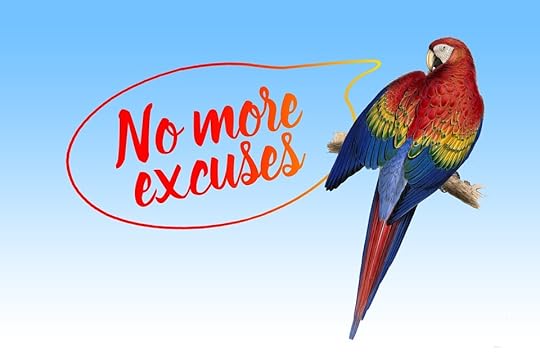
 Scarred, rescued scarlet macaws in Honduras. They are now flying free, but just barely escaped a life captivityReparations is replenishment of a previously inflicted loss. Reparations in the human realm often come in the form of apologies, financial awards, and land, and have been awarded to indigenous people, Holocaust survivors, abused women, and those wrongfully imprisoned or harmed. Currently in North America we have a lively discussion now about reparations for African Americans who are descendants of slaves. Part of this process is deciding who "pays" for the loss and who gets "paid," especially if there are no living survivors.It is possible that governments can take responsibility to lead the way in reparations. For instance, where once there was a million Puerto Rican parrots when Columbus arrived, by the 1970's there were only 13. Since then, despite devastating hurricanes, there are approximately 500 on the island. United States taxpayers funded this recovery through the United States Fish and Wildlife Service, and the Puerto Rican Department of Natural Resources. It is a remarkable story of partial replenishment. In other scenarios, individuals and nonprofit organizations seek to restore what once was so plentiful. Though there are stories of encouraging success, the majority of parrots are in real trouble, with no one in sight who can repair the damage done. But there are millions of people who could, you, or someone you know.I suggest that anyone who has ever had a parrot or enjoyed one in captivity rise up to repair the very broken relationships between human and bird. If you'd like to know why, follow the chains of the trade, if you have a parrot in your home, it might be directly taken from the wild, but most likely, her or his ancestors were wrongfully removed from their homes, often shipped thousands of miles away, many perishing on the perilous journey or soon afterwards.Every parrot in every home is linked back to the devastating trade. This fact might elicit some shame or anger, but mostly it is a statement of hope. By admitting the linkages between the beauty we love in the form of the parrot, and the great harm linked to it, we open our hearts to the possibility of reparrotions (reparations).If every person who has a bird now in captivity give one US$ to parrot conservation, we could raise 320 million from the top 12 countries who have pet birds. If we did this every year, along with a promise to not buy another bird, but only take rescue birds into our homes, the earth's parrot populations would be restored, as well as our spirits in knowing that we had done all we could.Be part of reparrotations.Donate to parrot conservation today.
Scarred, rescued scarlet macaws in Honduras. They are now flying free, but just barely escaped a life captivityReparations is replenishment of a previously inflicted loss. Reparations in the human realm often come in the form of apologies, financial awards, and land, and have been awarded to indigenous people, Holocaust survivors, abused women, and those wrongfully imprisoned or harmed. Currently in North America we have a lively discussion now about reparations for African Americans who are descendants of slaves. Part of this process is deciding who "pays" for the loss and who gets "paid," especially if there are no living survivors.It is possible that governments can take responsibility to lead the way in reparations. For instance, where once there was a million Puerto Rican parrots when Columbus arrived, by the 1970's there were only 13. Since then, despite devastating hurricanes, there are approximately 500 on the island. United States taxpayers funded this recovery through the United States Fish and Wildlife Service, and the Puerto Rican Department of Natural Resources. It is a remarkable story of partial replenishment. In other scenarios, individuals and nonprofit organizations seek to restore what once was so plentiful. Though there are stories of encouraging success, the majority of parrots are in real trouble, with no one in sight who can repair the damage done. But there are millions of people who could, you, or someone you know.I suggest that anyone who has ever had a parrot or enjoyed one in captivity rise up to repair the very broken relationships between human and bird. If you'd like to know why, follow the chains of the trade, if you have a parrot in your home, it might be directly taken from the wild, but most likely, her or his ancestors were wrongfully removed from their homes, often shipped thousands of miles away, many perishing on the perilous journey or soon afterwards.Every parrot in every home is linked back to the devastating trade. This fact might elicit some shame or anger, but mostly it is a statement of hope. By admitting the linkages between the beauty we love in the form of the parrot, and the great harm linked to it, we open our hearts to the possibility of reparrotions (reparations).If every person who has a bird now in captivity give one US$ to parrot conservation, we could raise 320 million from the top 12 countries who have pet birds. If we did this every year, along with a promise to not buy another bird, but only take rescue birds into our homes, the earth's parrot populations would be restored, as well as our spirits in knowing that we had done all we could.Be part of reparrotations.Donate to parrot conservation today.
Published on September 11, 2019 15:46



